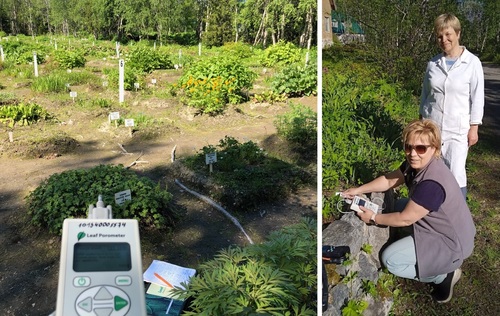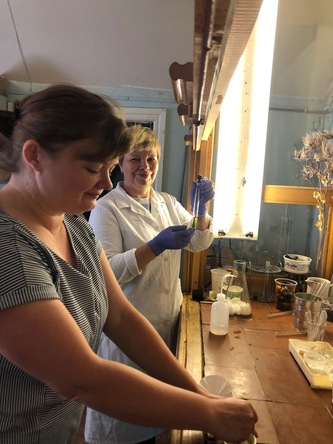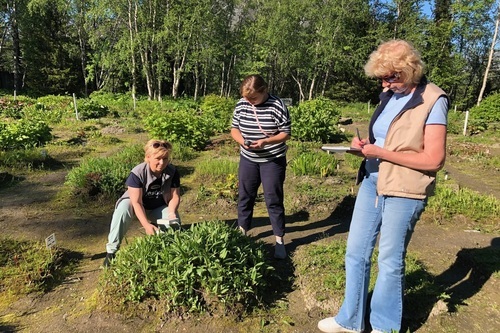– It is known that optimum plant illumination augments yields. However, illuminating plants with high intensity light is not economically viable. It turned out that the same results can be achieved by increasing the duration of illumination while reducing the intensity. Yet, prolonged constant light exposure, even at low intensities, can stress the plants. Even that can be beneficial, though, as plants respond to stress by producing antioxidant defenses that increase the nutritional value of the produce, such as leafy vegetables or microgreens. Furthermore, even two or three days of round-the-clock lighting reduce the nitrate content in plants, improving their biosafety, – explained Tatyana Shibaeva, Leading Researcher at the Laboratory of Plant Physiological Ecology, Institute of Biology KarRC RAS.
Not all crops however are equally tolerant of constant light exposure. The photosynthesis rate may decline, and some species are notably damaged, with yellowing of leaves (chlorosis) and tissue die-back.
– For us to better understand the response of plants to 24h illumination, it was important to study the mechanisms of plant responses in the wild. We wondered why plants are damaged under constant artificial light, but this doesn't happen in a natural environment during polar day, when they are exposed to constant light for more than three months, — the physiologist said.
Scientists took several study trips to the Polar-Alpine Botanical Garden-Institute of the Kola Science Center (PABGI KSC RAS), where they explored the reaction to natural round-the-clock lighting, and later also to artificial illumination in climatic chambers, in native plants that have long been growing in the north, and in plants introduced to Kirovsk from the Himalayas and the Balkan Peninsula.

Measuring stomatal conductance — the extent of opening of stomata — gateways for gas exchange in plants. Tatyana Shibaeva and Natalya Shmakova, Chief Researcher at PABGI KSC RAS.

Alexandra Rubaeva, Doctoral Student at IB KarRC RAS, and Natalya Shmakova measuring the content of photosynthetic pigments in plant leaves
The study objects were two species of cranesbill — wood and Himalayan, two species of avens — water and scarlet, two species of cinquefoil — erect and dark crimson. The principle for selecting species pairs was as follows: one species from the local native flora and a species of the same biological genus introduced in the Subarctic.
Physiologists hypothesized that the native plants have managed to adapt to polar day conditions through long evolution while the introduced plants would not be adapted.
The results of the study were published in the Plants international journal. It was found that both groups of plants lack specific mechanisms of resistance to 24-hour light and the defense reactions are of general nonspecific nature. It's only that the defense in native plants is more active due to the generation of phenolic compounds.
— In climatic chambers with constant ambient conditions, artificial continuous light exposure causes leaf damage due to oxidative stress. We arrived at the conclusion that its main cause is circadian asynchrony - a mismatch between the plant's internal rhythms and the external light-dark cycles. This is similar to accelerated aging, when irreversible damage accumulates in cells. Under constant light in climatic chambers, such changes became visible within two weeks, — remarked Tatyana Shibaeva.
In the wild, plants are not photodamaged during the polar day because their internal rhythms are maintained by daily fluctuations in environmental factors: intensity of solar radiation, spectral composition of light, air temperature and humidity. Moreover, the spectral composition of sunlight is better for harmonious development of plants compared to the light of phytolamps, which is most often set to maximize the rate of photosynthesis.
Another article by Karelian scientists in the Plants deals with the impact of abnormal light-dark cycles on the growth and development of plants of the family Solanaceae (Nightshades).
It was demonstrated that extended light/dark cycles (24/12 h, 48/24 h, 96/48 h, 120/60 h, and 360/0 h) affect plant growth, pigment content, and antioxidant status. The effects varied with plant species and duration of light/dark cycles. For example, if tomato and paprika seedlings were grown at 48/24 h, 96/48 h, and 120/60 h, they subsequently produced higher fruit yields than under normal photoperiods (16/8 h).
Scientists suppose that extended light/dark cycles can enhance the efficiency of light utilization compared to a normal photoperiod and thus reduce the cost of production, but before translation into practice, the effect needs to be studied in more detail for individual plant species or even varieties.






